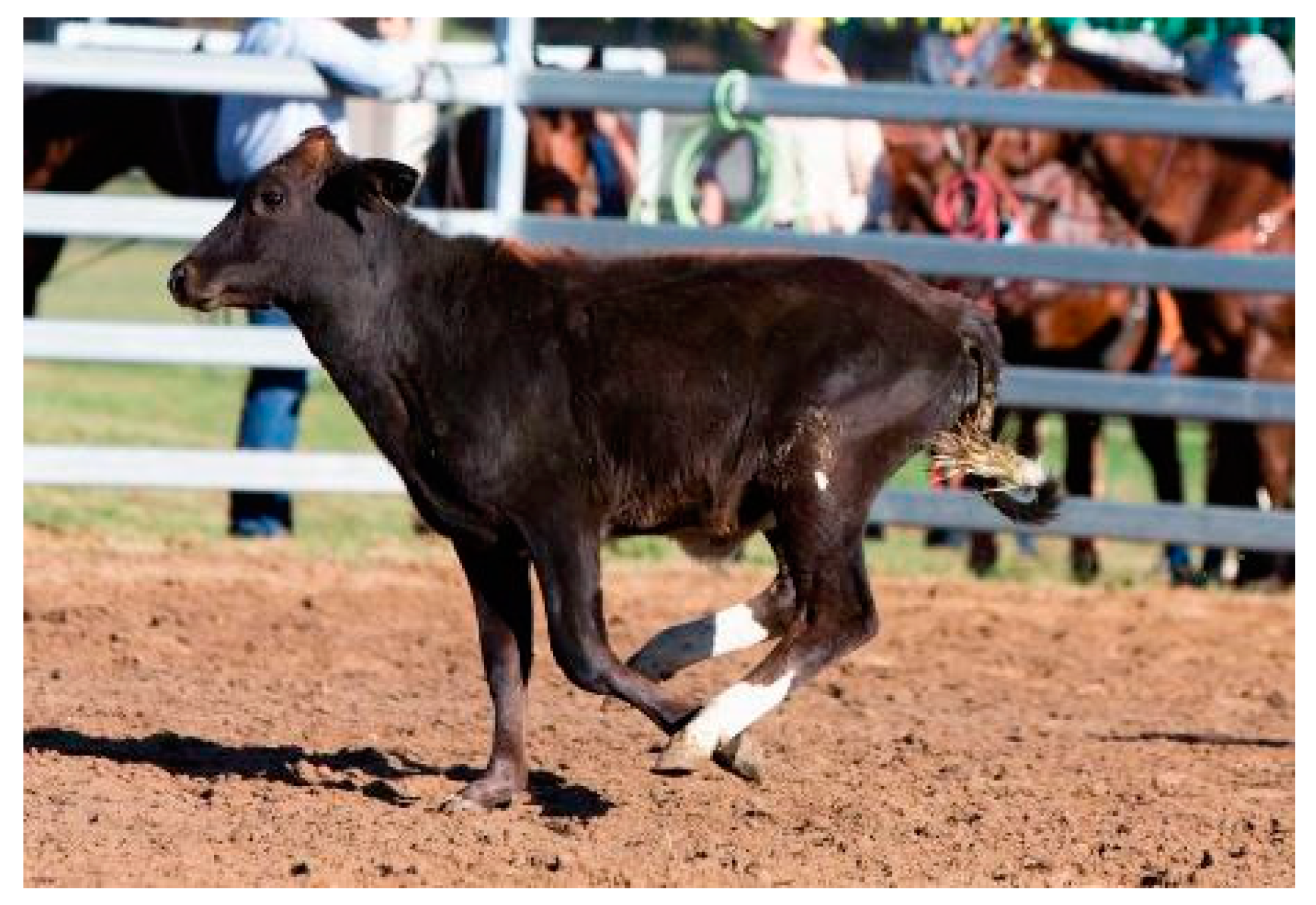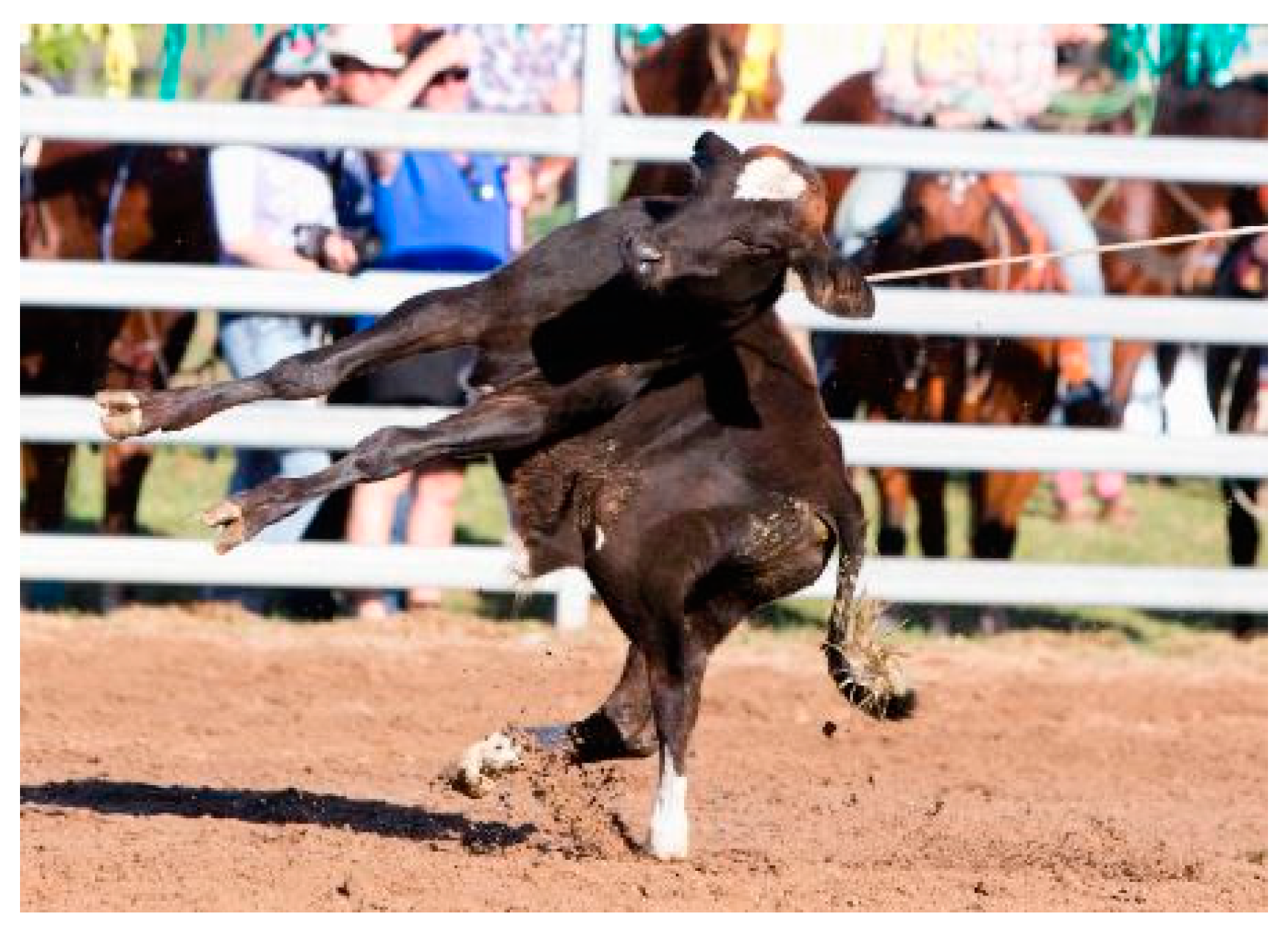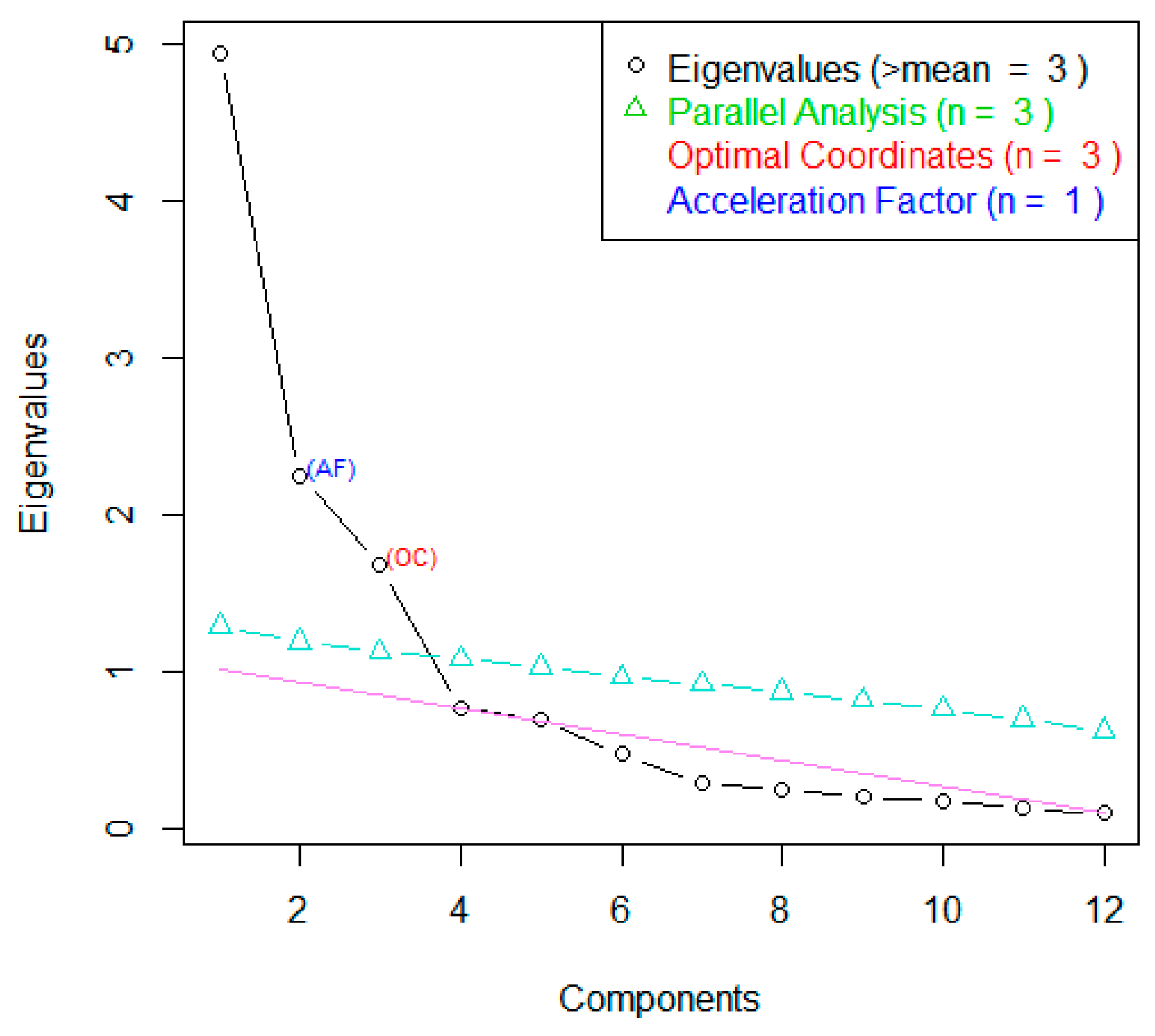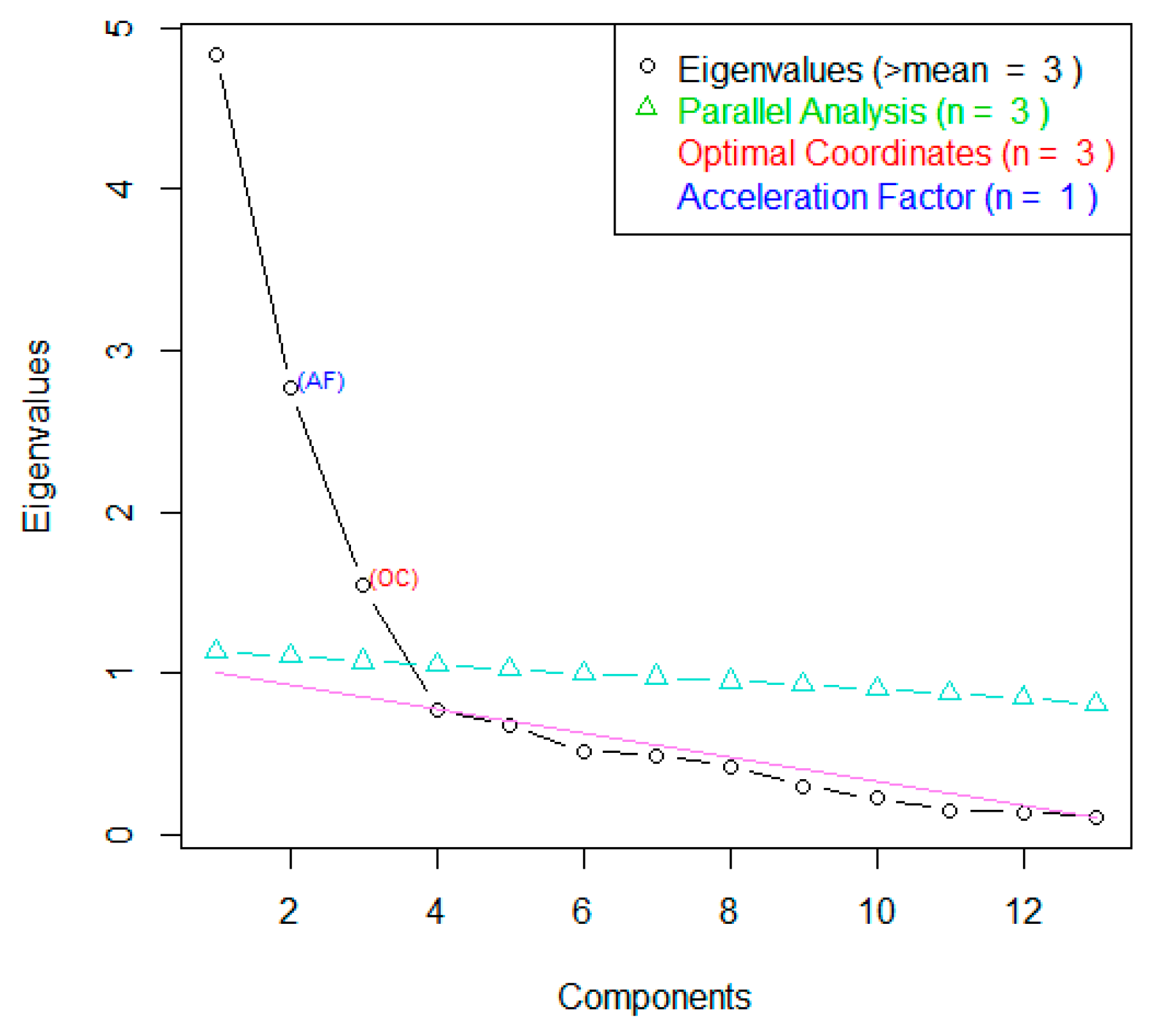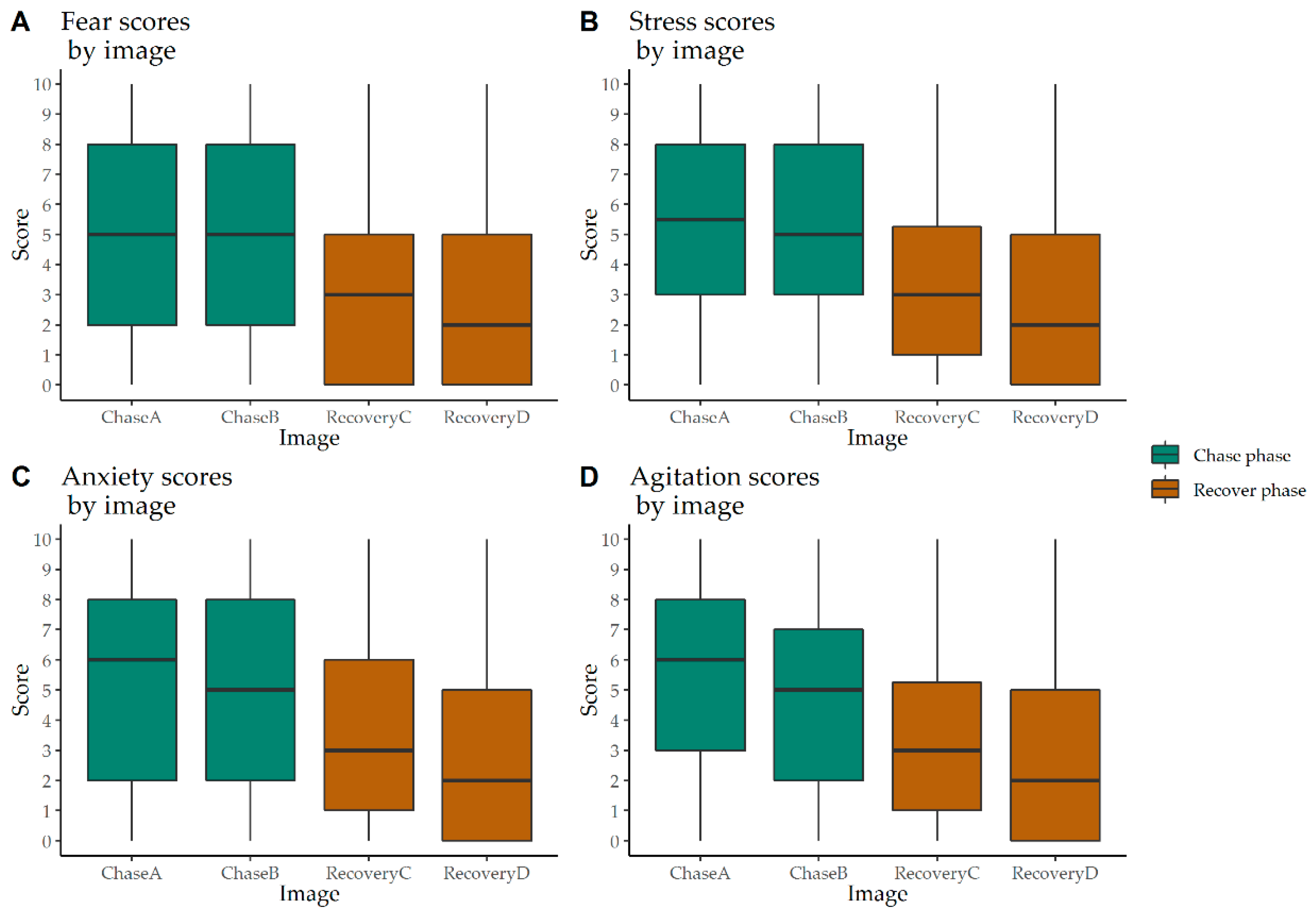1. Introduction
Rodeos originated from cattle-ranching culture and were initially used to hone and display the everyday practical skills that stockpersons needed to run a successful ranch [
1]. In particular, calf-roping was used on farms to facilitate the performance of routine veterinary procedures, such as castration and dehorning. With the progressive transition from horse-backed ranching to motor-vehicle-based ranching, rodeos developed into the current entertainment event [
1]. This means that currently the chief motivations for running rodeo events are economic gains, entertainment and competitive sportsmanship rather than the practical application of skills.
Given the current focus on entertaining audiences, rodeos are subject to criticism for their alleged disregard for animal welfare [
1,
2]. In Australia, the United States of America, and Canada, the six most common rodeo events are saddle bronc-riding, bareback-bronc riding, bull-riding, steer-wrestling, team roping, and rope-and-tie (calf-roping) [
3]. Of these events, calf-roping is perhaps subject to the most scrutiny from concerned observers. It involves a calf being released from a barrier or chute and chased by a competitor on horseback. The rider’s goal is to rope the calf, dismount, then run to and throw the calf onto their side in order to tie three of their legs together [
3]. The competitor’s time is recorded at the completion of the tie. The rider must then remount and release the tension on the rope to show that the tie holds [
3]. The winner is the competitor with the fastest time and a secure tie. The
Figure 1 and
Figure 2 depict different stages of calf-roping.
Animal advocates have voiced several concerns about calf-roping. These include the prospect that calves can suffer physical injuries when roped and thrown to the ground, including broken bones and internal injuries such as haemorrhage and tracheal damage, some of which may necessitate euthanasia [
4]. Furthermore, animals are subject to fear-eliciting scenarios that elevate levels of stress and suffering [
5]. In their defence, the rodeo industry and related stakeholders maintain that rodeo animals are treated humanely and with dignity, are protected in Australia under the Code of Conduct for the Welfare of Rodeo Livestock and have a low injury rate [
6]. The rodeo industry states that “one injury is recorded for every 3471 times an animal is used [and] one animal is severely injured or euthanised for every 5571 times an animal is used” [
6]. Competition rules for calf-roping include disqualification and fines for ill-treating stock, severe jerking or throwing animals to the ground and if the horse drags the calf more than 1 metre [
7]. Also, an approved roping device [
8], which is designed to work as a shock absorber and thus reduce the force of the rope around the animal’s neck, must always be used under industry rules [
7]. It is also important to note that despite the colloquial name for this event being “calf-roping”, its official name is the Rope and Tie. Animals must be more than 100 kg, have been weaned and be at least 12 weeks old [
7,
9]. Nevertheless, for the purposes of contextualization, the current article will refer to these animals as calves. A minimum body weight limit of 200 kg for cattle has been set in Victoria and South Australia, effectively prohibiting calf-roping, as the maximum weight stipulated by at least one rodeo association is 140 kg, which is much less than 200 kg. Furthermore, weaned animals who are at least 200 kg would no longer be considered calves, and anecdotal reports indicate that it is too dangerous for the “calf” and the competitor to rope-and-tie an animal weighing over 200 kg, thus setting the minimum body weight limit of 200 kg for participating bovids effectively prohibits calves being roped.
Despite the history of conflicting views from the rodeo industry and animal welfare advocates, there is little research on the physiological, behavioural and emotional responses of animals participating in rodeo events. The limited published research focuses primarily on bulls and calves used in bull-riding and calf-roping [
1,
2,
10] and has reported contradicting results.
A study of bull behaviour at rodeos [
2] determined that 30% of 14 animals showed signs of distress leading up to the start of bull-riding events, which the authors reported as being low.
Physiological responses in the bulls were not reported in this study. In contrast, calves have been found to show physiological stress responses during calf-roping, irrespective of whether they had been roped before [
1].
Another study [
10] explored the short-term welfare of calves (
n = 30) roped at a rodeo. Changes in creatinine kinase, lactate hydrogenase enzymes and cortisol concentrations in calves that were roped were compared to a control group of calves that were present at the rodeo but did not take part in the roping event. Head-shaking and sham-chewing were evident in a third of the calves after they had been roped. There were significant increases in the concentrations of creatinine kinase, lactate dehydrogenase enzymes and cortisol in roped calves. However, these increases could not be attributed solely to being roped, thrown and tied because significant increases were found in calves who had been pursued by riders but not roped successfully.
The dearth of empirical data on perceived emotional states among animals participating in rodeos contributes to the difficulty faced by governing bodies when they attempt to make well-informed decisions about animal welfare. However, a unique research opportunity to address this knowledge gap recently arose with the introduction of new animal welfare legislation [
11] in Quebec, Canada, in 2015. According to this legislation, a person may not “cause an animal to be in distress” unless it is for agriculture, teaching, science or veterinary treatment, and is justified, minimal or cannot be alleviated. Although permitted use includes agricultural exhibitions and fairs, the legislation essentially excludes animals used for entertainment such as rodeos and circuses. This possible conflict led to researchers being granted access to rodeos to gather material to assess the welfare of the animals involved.
There is a growing body of work that supports the feasibility of using qualitative behavioural assessment (QBA) to assess the emotional state of animals. QBA is a method that involves observers viewing images and/or footage and then scoring, on a scale between a minimum and maximum score, using a series of descriptive terms according to how well they describe the emotional state of the animals in the images. Scores are analysed to determine common patterns between animals, treatment groups and individual observers [
12].
Historically, QBA has been successfully applied to assess the behaviour of dairy cows with clinical mastitis [
13], during stockperson interaction [
14] and in housing systems [
15], and beef cattle during transport [
16], transport and lairage [
17], castration [
18] and welfare assessments [
12,
19]. Other livestock applications include the assessment of behaviour and flock health in sheep [
20], and behaviour, emotionality and body language in pigs [
21,
22,
23]. QBA has also been applied to the behaviour assessment of horses during competition [
24] and affiliative and aversive human interactions [
25,
26], and even as an assessment tool for dogs entering shelters [
27,
28]. This extended body of published research suggests that QBA may be a reliable measure of the welfare of animals used in rodeos.
To our knowledge, there is no published study of audiences’ perceptions of animal use in rodeos. This knowledge gap may reflect the audience’s physical distance from the animals during rodeo events, a general lack of understanding of animal behaviour, disinterest in animal welfare or the overwhelming atmosphere of rodeos distracting viewers from watching individual animals closely. There is evidence that observers with relatively high empathy towards humans are more sensitive to indicators of cattle pain than less empathic observers [
29]. One landmark study surveyed veterinary science students and gathered information on gender, year of study, demographics and views on animal sentience using an attitude to animals questionnaire [
30]. This showed that gender and level of animal education are associated with perceived sentience in animals and emotional empathy towards them. Students in later years of study rated animals as having lower levels of sentience than students in earlier years and, throughout their studies, female students showed higher levels of empathy towards animals than male students did.
The objectives of the current study were to explore the feasibility of using QBA to characterise the behaviour of calves in still images from video footage taken at two different stages of the calf-roping event, and to identify if their behaviour varied between these stages. We hypothesised that QBA can be used to estimate different emotional states in calves as positive, negative or neutral as well as the intensity of what animals are experiencing emotionally before and after roping. Furthermore, the study explored whether observers’ scores for intensity of calves’ emotional state correlated to positive attitudes to animal sentience.
3. Results
3.1. Factors Contributing to Responses
Factor Analysis and Varimax rotation were conducted on the 12 FTDs from Round One. The Scree Plot (
Figure 3) showed points of inflexion after the fourth and third factor, with Factors 1–3 having an eigenvalue > 1. Cumulative variance showed that the first four factors explained 72% of the variance in this dataset. This suggests three-to-four potentially informative factors.
Factor 1 strongly loaded agitated, anxious, frightened and stressed, suggesting it represented negative emotions (
Table 1). Factor 2 strongly loaded energetic and excited, suggesting it represented positive emotions. Factor 3 strongly loaded calm and contented, suggesting it represented neutral emotions.
Similarly, Factor Analysis and Varimax rotation of the 12 FTDs were carried out on the Round Two responses. The Scree Plot (
Figure 4) showed points of inflexion after the fourth and third factors, with Factors 1–3 having an eigenvalue > 1. Cumulative variance showed that the first four factors explained 69% of the variance in this dataset. Once again, this suggested three-to-four potentially informative factors.
Factor loadings for Round Two were broadly similar to Round One. Factor 1 strongly loaded agitated, anxious, frightened and stressed, again suggesting it represented negative emotions (
Table 2). Factor 2 strongly loaded calm and contented, suggesting it represented neutral emotions and is similar to Factor 3 in the Round One loadings. Factor 3 strongly loaded energetic and excited, suggesting it represented positive emotions and resembled Factor 2 in the Round One loadings.
The underlying factors for Round Two differed between the chase and recovery phases (
Table 3). Round Two scores for Factors 1–4 were significantly different for the recovery phase when compared to Chase A. Scores for Factor 3 in Chase B were also significantly different from those in Chase A.
3.2. Chase versus Recovery Phases and Intra-Phase Similarity
Mean scores for chase and recovery phases were calculated from the Round Two dataset. Compared with those for the recovery phase, the scores for the chase phase were higher for agitated (µ = 5.1), anxious (µ = 5.0), confused (µ = 3.0), energetic (µ = 4.3), excited (µ = 2.9), frightened (µ = 5.0) and stressed (µ = 5.1). In contrast, the recovery phase scored higher for calm (µ = 3.0), contented (µ = 2.7), exhausted (µ = 2.3), inquisitive (µ = 2.5) and relieved (µ = 1.6).
Ordinal Logistic Regression was conducted on the 12 FTDs from Round Two, comparing Chase A to Chase B, Recovery C and Recovery D. A strong recovery effect emerged for relieved, calm, contented, frightened, stressed, anxious, and agitated (
Figure 5 and
Figure 6).
Scores for relieved were significantly higher (p < 0.001) during both recovery phases than in Chase A. Likewise, calm and contented scores were also significantly higher (p < 0.001) in both recovery phases. Scores between chase phases for these three FTDs were not significantly different. For frightened and stressed, both recovery phases scored significantly lower (p < 0.001) than the chase phases. Likewise, anxious and agitated scored significantly lower (p < 0.001) in both recovery phases than the chase phases. However, in the chase phase, scores among these four FTDs were not significantly different.
Recovery scores for inquisitive were significantly higher (p < 0.001) than Chase A, but so too were Chase B scores (p = 0.049). Recovery scores for energetic were significantly lower (p < 0.001) than Chase A, and Chase B were significantly higher (p = 0.0498). Recovery scores for confused were lower than Chase A but this was attributed chiefly to scores in Recovery D (p = 0.001). Scores between Chase A and Chase B were not significantly different. Recovery scores for excited were also lower than in Chase A, but this was significant for only Recovery C (p < 0.001). Chase B excited scores were also significantly higher than Chase A (p < 0.001). Recovery scores for exhausted were higher than Chase A, but this was significant only for Recovery D (p = 0.023). Scores between Chase phases were not significantly different. Unfortunately, due to the limited number of observers, it was not possible to compare responses within the student group by their attitudes to animals. Future studies to explore this relationship would benefit by having a sufficient number of observers.
3.3. Reliability of Scoring
Intra-Class Correlation Coefficients (ICCs) were calculated (
Table 4) to measure the reliability of scoring within and between Round One and Round Two. ICCs for Round One were lower than for Round Two and, in some cases, not significantly different from zero.
For Round One, ICCs ranged from −0.00775 (confused) to 0.306 (calm) with reliability being highest (ICC > 0.3) for calm only. For Round Two, ICC ranged from 0.0983 (confused) to 0.361 (calm) with reliability being highest (ICC > 0.3) for agitated, calm, frightened and stressed. Between Round One and Round Two, ICCs were similar for anxious, calm, excited and exhausted.
3.4. ETA
The responses from Part 3 of the ETA survey (n = 16) were compared to the QBA scores for each participant. Observers who more strongly agreed with “I hate seeing pictures of animals used in scientific experiments” and “Seeing animals in pain upsets me” had significantly higher Principal Component Factor 1 scores for Chase A than those who less strongly agreed (p = 0.01, p = 0.03, respectively). Principal Component Factor 1 was mainly composed of agitated, anxious, stressed, frightened and confused.
Observers who more strongly agreed with “I get annoyed by dogs that howl and bark when they are left alone” and “Often cats will meow and pester for food even when they are not really hungry” revealed more differences in FTD scoring between chase and recovery phases than those who less strongly agreed (p = 0.02, p = 0.03, respectively).
3.5. Ethogram
Binary logistic regression modelling was used to determine the most prevalent behaviours displayed by the calves during chase and recovery stages. Behaviours that were significantly more common in the chase phase than in recovery were Legs Gallop (Likelihood Ratio χ2 = 22.206; p < 0.001) and Tail Held Rigid (LR χ2 = 6.585; p = 0.010). Behaviours that were significantly more common in the Recovery phase than in the Chase phase were Ears Axial (LR χ2 = 7.034; p = 0.008), Ears Forward (LR χ2 = 6.560; p = 0.010), Legs Slow Run (LR χ2 = 20.360; p < 0.001) and Legs Fast Walk (LR χ2 = 13.983; p < 0.001).
4. Discussion
The QBA scoring showed a clear pre- and post-rope effect on the emotional state of calves observed during the calf-roping event. Observers thought that calves during the chase phase were more agitated, anxious, confused, energetic, frightened and stressed. Agitation, anxiousness, fear and stress, as well as calves commonly holding their tails rigidly, are attributed to the calf being pursued by a rider on horse-back at speed, most likely simulating a predator/predation effect. Similarly, confusion scores may be a result of this predation effect, but could also be credited to calves struggling to take in as much information as possible about their surroundings and atmosphere at the time of release from the holding chute. The ethogram scores for the chase phase indicate that the calves were always galloping and may explain why observers viewed calves as being energetic.
In contrast, observers scored calves in the recovery phase as more calm, contented, exhausted, inquisitive and relieved than in the chase phase. Calmness, contentedness and relief were most likely a result of the rope being removed and no horse and rider chasing the calf at speed. The ethogram scores showed that calves were moving slower during the recovery phase than in the chase phase. This may help to explain why observers saw the calves as exhausted, as well as calm, contented and relieved. Linked to the higher scores for confused in the chase phase, inquisitiveness in the recovery phase was most likely a response to the calves assessing their surroundings, though this time in a more relaxed emotional state. Inquisitiveness was also suggested from the behavioural scoring of ear position being more commonly axial and forward, rather than pinned or facing backwards. These results indicate that the use of a QBA approach differentiated emotional states of calves between the chase phase and the recovery phase. In addition, observers identified specific emotional experiences expressed by calves during the chase phase that were characterised by more negative experiences than in the recovery phase. Although the 20 calves whose images were used were roped by different riders, it is possible that the skill and speed of competitors may influence the behaviour and emotional state of calves. To explore the effects of riders’ skill levels on calf welfare, future studies may factor-in the level of competition of the events in which the calves are being used.
The differences in emotional state during chase and recovery phases seen in this study suggest that roping events induce an acute stress response in calves. This supports recent research [
1] where serum cortisol, epinephrine and nor-epinephrine concentrations of calves increased after being roped but were no longer significantly elevated 2 h post-roping. Given that these hormones are often recognised as indicators of stress, this would explain why scores for stressed and agitated were significantly lower in the recovery phase than the chase phase. Likewise, the change in pace of the calves between the phases, from galloping to slow running/walking, suggests an immediate change in emotional state. However, it should be noted that another study found that not only were cortisol concentrations increased in calves after the roping event, but they were further elevated at 24 h [
10]. In that study, head-shaking and sham-chewing were evident in a third of the calves after they had been roped. There were significant increases in the plasma concentrations of creatinine kinase, lactate dehydrogenase enzymes and cortisol in roped calves. However, these increases could not be attributed solely to being roped, thrown and tied because significant increases were also found in calves who had been pursued by riders but not roped successfully. It is possible that physiological measures 24 h after roping may be unrelated to the specific intervention of current interest (i.e., roping) and could be compounded by marshalling or herding, transporting and blood sampling.
Human interaction may have also played a role in observed changes to the behavioural and emotional states of calves in this study. Calves appeared to be more calm, contented and relieved and moved slower when little human interaction was present; i.e., in the recovery phase when the rope had been released and the calf had been left alone to exit the arena. In contrast, calves were more stressed, frightened, anxious, agitated and moved faster when human interaction was intense; i.e., during the chase phase. Similar responses to human interaction at rodeos have been reported [
2] in bucking bulls during marshalling and mounting phases of bucking bull events, where behaviours also likely to be associated with stress and anxiousness such as rearing and tail-swishing, were exhibited. Half of those who showed such signs did so in association with human interactions, such as when personnel were approaching or standing at the head of the bull or standing in the bull’s direct line of sight, or pre-empting release from the chute as riders were preparing to mount the bulls. None of these behaviours appeared to compromise the bucking performance of the animals. Given that this study revealed less conflict behaviour among the veteran animals, it may suggest that animals become habituated to events associated with rodeos. However, the authors acknowledged that they were unable to explore whether the lack of proactive conflict behavior in these animals was in itself a manifestation of learned helplessness, rather than habituation.
Observers in Round One, who had extensive cattle experience, showed less agreement than the students on how they scored each image. It may be that variation in level and type of experience contributes to how observers assess emotional states in animals. Over the course of their careers, practitioners have honed their observation skills in assessing the emotional and behavioural state of animals under veterinary care, which may be why the only term consistently scored by practitioners was calmness. A previous study [
29] has found that veterinarians consistently identified procedures that were painful for animals, but it may be that seeing animals in states of pain, fear and stress over years of clinical practice could desensitise them to subtler changes in the emotional and behavioural states of calves used in the entertainment industry. This may contribute to the relatively low agreement across the other emotional descriptors.
Student observers showed higher agreement than practitioners in how they scored images. They agreed the most on calm, agitated, frightened and stressed. Compared to practitioners, current students are likely to be undergoing similar education, an attribute which could explain why they have higher agreement. Furthermore, students may not be desensitised to seeing animals undergoing emotional challenges. The current ETA data revealed that students who had more empathy for animals in pain and for those used in experiments were more empathetic towards calves during the chase phase. They felt that calves being chased were agitated, anxious, stressed, frightened and confused. To the authors’ knowledge, this is the first report of links between empathy towards animals and QBA scoring. As the ETA survey was not conducted with the practitioner group, the influence of attitudes to animals could not be evaluated in relation to the observation response scores for this group.
Despite there being low rate of agreement within both rounds as shown by the ICC scores, there was a moderate level of agreement between rounds as evident by the similarities in the Principle Component Analysis. Factor 1 was broadly similar in both rounds, Factor 2 in Round One resembled Factor 3 in Round 2, and vice versa. This implies that scoring within both groups was influenced by the same groupings of emotions, whether they were negative, positive or neutral emotions. Unfortunately, due to the limited number of observers, it was not possible to compare how the ICC of responses within the veterinary/animal science student group changed in association with their attitudes to animals. Future studies to explore this relationship would benefit by having sufficient a number of observers
One limitation of the current study was the use of still images as, generally, QBA studies use video/film footage for FTD scoring. This may have contributed to lower scores of agreement as video footage provides a more holistic view of the animals’ emotional state and provides context as to the animal’s surroundings within that space of time. In any attempt to identify emotional state, the use of only two still images depicting each of the chase or recovery phases might be considered brief. However, given the rapid speed of calf roping events, it is reasonable to assume that these still images are representative; i.e., on average, the chase phase lasts less than four seconds. Also, observers were blinded to the nature of the event occurring. Furthermore, still images have been used in other studies to detect the presence of pain in horses [
33,
34]. Also, it should be noted, compared to video footage, that still images are less likely to capture all aspects of body language. Thus, the quality of the QBA scoring for still images may not be as high as for video footage.
Another potential limitation was the difference in sample size between Round One and Round Two. The smaller sample size of Round One compared to Round Two may contribute to less accurate ICC scores. It should also be noted that there was some variability in the level of experience in the observer groups. Lastly, recruitment of participants from a limited pool of students was countered by the use of the empathy survey. By taking into account how observers viewed their own level of empathy towards animals, it enabled links to be drawn between how a wider audience with different levels of empathy towards animals may assess animal emotional states.
Rather than using still images, further QBA studies in this area should use footage of calves during roping events. Rodeo-specific elements in these videos, such as background features, ropes, rodeo horses and competitors could be obscured; e.g., by pixelation. Future research could also aim to explore associations between perceived emotional state during chase and recovery phases with physiological measures.
